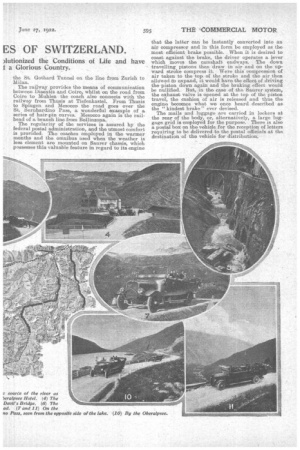THE ALPINE POSTAL ES• OF SWITZERLAND.
Page 14

Page 15

If you've noticed an error in this article please click here to report it so we can fix it.
ROAD engineering in. Switzerland long ago attained a very high level (the double entendre was quite unintended!), so that the villagers have always, so long as the roads remained open, enjoyed the benefits of intercommunication by means of horsed vehicles. But the coming of the motor vehicle has effected an even greater revolution in. the lives of the Swiss villagers than amongst those who live in countries where transport is comparatively easy. The saving. of time on the part of the motor coach in a mountainous region is enormous, the
i gain n speed on the upward gradients, great as it is, being outshone by the infinitely higher speeds on the declines. . What engine, power aceoraplishes on the ascents is inoro than matched by what an -ample reserve of brake power will allow on the descents.
The vehicle. which plays such an important part over the Alpine roads is the motor coach, which is employed in the carriage of passengers and mails. The federal postal authorities make an extensive use of the • coach, running regular services/ between Meiringen and Gletsch, a distance of 37 kilometres (23 miles); Gletseh and Andermatt, 32 kilometres, or nearly 20 miles ; Andermatt and Diseritis, 33 kilometres, or 201 miles; Thusis and Splugen, 26 kilometres, or a little more than 16 miles ; Splugen and Mesocco, 41 kilometres, or 25:1 miles; Goire and Muhlen, 50 kilometres, or 31 miles, and between Reichenau and. Films, 14 kilometres, Or over 81 miles.
At Meiringen the coaches connect with the railway from Berne and Lucerne and travel through the Grirosel Pass to Gletseh, where the railway from Lausanne terminates. Turning north-eastward the Furka Pass is traversed to Andermatt and the Oberalps road to Disentis, the glacier from which the river Rhone emerges being one of the striking sights on the route. At Andermatt is the entrance to
The railway provides the means of communication between Disc/ibis and Coire, whilst on the road from Coire to Muhlen the coach also connects with the railway from Thusis at Tiefenkastel. From Thusis to Splugen and Mesocco the road goes over the St. iiernhardino Pass, a wonderful example of a. series of hair-pin curves. Mesocco again is the railhead of a branch line from Bellinzona.
The regularity of the services is assured by the federal postal administration, and the utmost comfort is provided. The coaches employed in the warmer months and the omnibus used When the weather is less clement are mounted on Sa,urer chassis, which possesses this valuable feature in regard to its engine that the latter can be instantly converted into an air compressor and in this form be employed as the most efficient brake possible. When it is desired to coast against the brake, the driver operates a lever which moves the camshaft endways. The down travelling pistons then draw in air and on the upward stroke compress it. Were this compression of air taken to the top of the stroke and the air then allowed to expand, it would have the effect of driving the-piston down again and the braking effect would be nullified. But, in the case of the Saurer system, the exhaust valve is opened at the top of the piston travel, the cushion of air is released and thus the engine becomes what we once heard described as the "kindest brake" ever devised.
The mails and luggage are carried in lockers at the rear of the body, or, alternatively, a large luggage grid is employed for the purpose. There is also a postal box an the vehicle for the reception of letters requiring to be delivered to the postal officials at the destination of the vehicle for distribution.






























